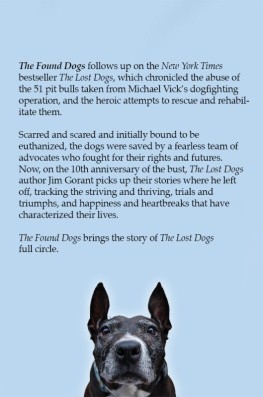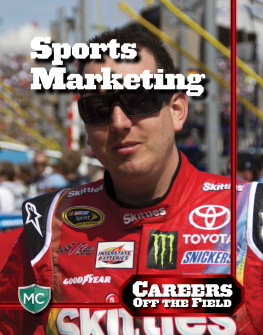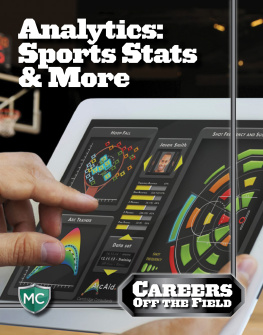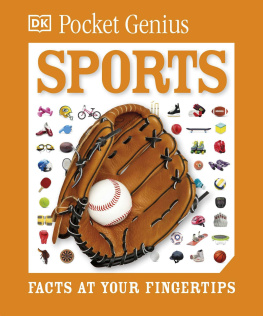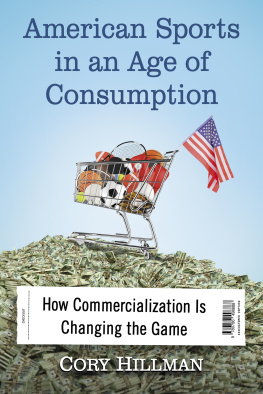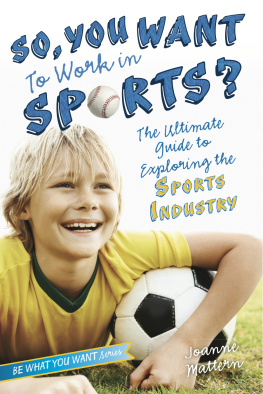First Mariner Books edition 2008
Copyright 2007 by Jim Gorant
All rights reserved
For information about permission to reproduce selections
from this book, write to Permissions, Houghton Mifflin Harcourt
Publishing Company, 215 Park Avenue South,
New York, New York 10003.
www.hmbbooks.com
Library of Congress Cataloging-in-Publication Data:
Gorant, Jim.
Fanatic : ten things all sports fans should do
before they die / Jim Gorant.
p. cm
Includes index.
ISBN 978-0-618-61298-7
ISBN 978-0-547-05363-9 (pbk.)
1. Gorant, Jim. 2. Sports spectatorsUnited States
3. SportsSociological aspects. I. Title. II. Title:
Ten things all sports fans should do before they die.
GV 715. G 67 2007
796dc22 2006033831
Printed in the United States of America
Book design by Victoria Hartman
DOC 10 9 8 7 6 5 4 3 2
Most names and some identifying details of the people who appear in
this book have been changed in order to protect the privacy of those
involved. For narrative purposes, the book contains some composite
characters, transferred dialogue, and condensed scenes. In writing
chapter 8 I used The 100-Yard War by Greg Emmanuel (John Wiley &
Sons, 2004) as a reference, and for chapter 9 I used Mudbaths and
Bloodbaths by Gary D'Amato and Cliff Christl (Prarie Oak Press, 1997).
Photo credits: : AFP Col
lection/Getty Images: :
Tom Pidgeon/Getty Images; : Travis
Lindquist/Getty Images. All other images were taken by the author.
For my mother,
L UCY T SANGARIS G ORANT
October 12, 1942, to June 24, 2004
Introduction
WHADDAYA SAY, PATRIOTS?" I don't say anything. He shouts again, "What do you say, Patriots?" His face is now so close, I can see the blondish stubble of his beard reemerging after that morning's shave, and if I chose to I could give a fairly detailed accounting of his dental work. I don't choose to.
At this proximity, our faces are like mirror images, but they're quite different. Mine is clean and largely expressionless, save the raised eyebrow. His is painted with a primal combination of blue, red, and silver, and twisted into an expression, of what, exactly? Pain, anger, enthusiasm? I can't say. Nor can I say why he's chosen to ask me this question. Has he mistaken me for a fellow Patriots fan?
It is the Friday before Super Bowl XXXIX, which this year features the Philadelphia Eagles and the New England Patriots, and we are at The Landing in downtown Jacksonville, a sort of outdoor mall and plaza that has already become the alcohol-fueled core of the three-day pregame party both sets of fans will take part in.
Almost everyone here has some sort of identifying mark, whether it's a hat, T-shirt, team jersey, or otherwise. Two guys with actual Eagles football helmets drink their beer through straws. Dozens of grown men in green face-paint high-five each other upon passing. Those who don't are local residents who've come down to join the party or check out the scene. I, in contrast, have nothing on that would indicate I'm for either team. I'm as neutral as neutral can be. Maybe that's why this guy has chosen to get in my face. He needs me to declare my allegiance one way or the other. Friend or foe? I don't know, but I do know that as the question hangs there between us a palpable tension grows. He's shirtless. He's drunk. He's right in my face.
The reason I'm nose to nose with the face-painter is because I'm an idiot. Not in the same way that he's an idiot, exactly, but an idiot nonetheless. Ever since I was, maybe, five, I've been addicted to sports. I played them all. I watched them all. Football, baseball, basketball, hockey, tennis, golf, badminton, pro wrestlingfor chris-sakes, my brother and I followed Australian Rules football on ESPN before the network could afford real programming. I've watched not just the Grey Cup, the Canadian Football League version of the Super Bowl, but regular-season games as well; at one point I could name the starting lineup of the Montreal Alouettes.
I was never a total stat nerd, but by second grade I'd mastered the calculus of scoring a tennis match. By third grade, I could tell you all the divisions and conferences of all the major sports, how their playoffs worked, where the wildcard teams came from, and how to calculate who had the home-field advantage. By fourth I understood that "questionable" meant a player had a 50 percent chance of playing, while "doubtful" dropped the odds to 25 percent.
Most kids pined for Christmas; I loved early spring and midfall. In spring, baseball returned, basketball and hockey moved into the playoffs, and college basketball reached its seasonal climax. In October, the NFL was going strong, college football bustled with rivalries and showdowns, baseball played out its bittersweet endgame, and the NBA and NHL began to rev up. The virtual orgy of sports wasand still isa sports fanatic's dream come true.
Growing up in northern New Jersey I developed deeply felt regional allegiances. Giants, Yankees, Rangers, Knicks. (This was a typical trend along the Connecticut-Westchester-New Jersey axis. East of Manhattan lay Met, Jet, Islander territory, although the arrival of the Nets and the Devils and the Jets' move to Jersey have muddled the picture in recent years.) College football: Penn State. College basketball: uncommitted. I loved them all.
In 1976 I was nine years old and the Giants signed Larry Csonka, fresh from his disastrous stint in the World Football League. Csonka was not the player he'd been as the centerpiece of the great Miami Dolphins teams of the early to mid-1970s, but the Giants had been so bad for so long that anything that had even the slightest crumb of success clinging to it was welcomed like an ice cube in a European restaurant. No surprise then that when I found out the Zonk, as my dad called him, would be signing autographs at a local car dealership, I forced my mom to haul me over there.
I still have the autograph"Thanks for visiting DeMassi Cadillac" scribbled across a glossy black-and-white photo of the Zonk, who smiles out from under his comically twisted nose and cheesy Magnum, PI mustachebut I remember little about the meeting with the future Hall of Famer. He sat on a chrome barstool with a black leather seat and wore a sport jacketwhich threw me. I think I was expecting him to be in uniform. It was the first time I'd ever met a professional athlete, and I'd never imagined them as real people with lives off the field; somehow they didn't exist to me in any way but the way in which I always encountered them, suited up and ready to play. He asked my name. I can't remember but I must have responded because the autograph reads "To Jim," although it's possible that in my shell-shocked muteness my mother responded for me. My father, who'd once seen Csonka in a restaurant, had talked about the size of his thighs, but what caught my attention were his hands. Meaty, tangled, snarled, and powerful, they were hands that knew things. They had held on to footballs at the bottom of ruthless piles, had led the charge on countless devastating forearm shivers, and had been held aloft in the ultimate triumph.
The mildly homoerotic undertones of the exchange were lost on me then, but the larger picture was not. I came away thinking three things: Larry Csonka was my favorite football player; there could be nothing greater in the world than to be a professional athlete; sports were awesome. The meeting had such an impact on me, in fact, that as the legend goes, my family was awakened several times over the next few weeks by the sound of my voice ringing out in the deepest part of the night. They were used to me talking in my sleep (a childhood affliction I eventually outgrew), but this was different. There were variations, but the content usually went something like this: "Csonka off the left side. He breaks a tackle at the 20. He's at the 10, the 5, touchdown!"
Next page

